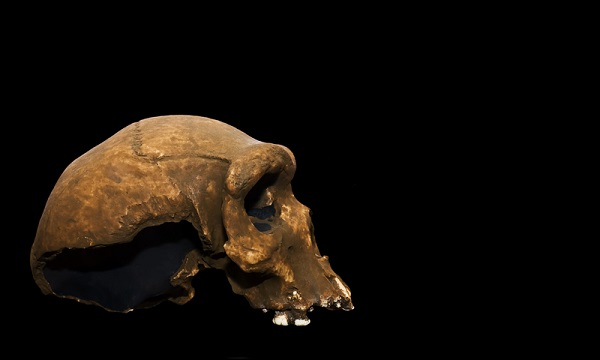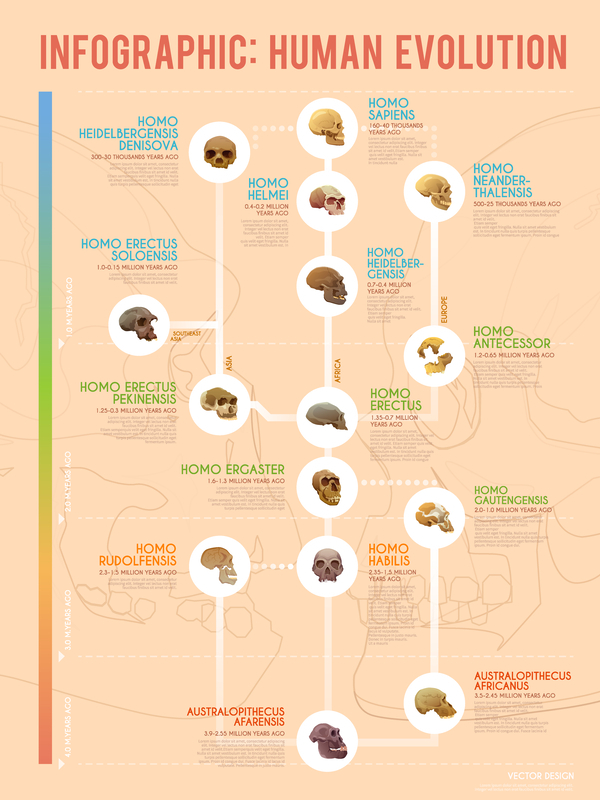

The Kabwe cranium, also known as the Broken Hill cranium, is a fossilised human (genus Homo) head that was discovered in 1921 not far from Kabwe, Zambia (then Broken Hill, Northern Rhodesia). It was the first premodern Homo fossil found in Africa. Along with a jaw fragment, a sacrum, and pieces of the pelvis and limb bones, a nearly complete skull was also discovered. The fossils were originally given the scientific designation H. rhodesiensis and are often referred to as Rhodesian man.
The great flat maxillaries, which lack canine fossa, are particularly comparable to the great flat maxillaries of the L-Chappelle skull. The infra nasal area is exceptionally deep, the lateral border of the narial aperture extends down on the face (as in the gorilla), allowing the premaxillary surface to flow into the floor of the narial cavity without interruption, and the nasal bones are more softly inclined. The prominent forward nasal spine that is characteristic of humans. Despite how closely the new skull from the Rhodesian cave resembles the skull of a Neanderthal man, the two skulls may not belong to the same race because of differences in the foramen magnum's location and braincase form.
Thus consider the Rhodesian caveman as a new species that may be considered to be particularly different from Homo neanderthalensis and can be given the name Homo rhodesiensis. Only further findings will be able to pinpoint the precise systematic location of this novel species of early man. Since Homo rhodesiensis still has a nearly Neanderthal face together with a more contemporary brain-case and modern bones, the recently found Rhodesian man may revive the theory that Neanderthal man is actually an ancestor of Homo sapiens.

Figure 1: Skull 200000 years old of Homo Rhodesiensis
Greater average brain volume (1212 cm3)
Rounded parietal bones give the skull a barrel-like appearance when viewed from behind.
Cranial capacity ranges between 1250 and 1400cc.
Inflation of the maxillary bones, which leads to the development of midfacial prognathism and the presence of big noses.
The formation of a retromolar gap, or the space between the mandible ascending ramus and the lower third molar.
Olduvian to La Mousterian tool cultures produced a variety of tools, with flake tools predominating.
The nasal aperture is enormous. The orbits are large and high.
They exhibit traits shared by contemporary humans and neanderthals, making them considered intermediate.
| Kingdom | Animalia |
| Phylum | Chordata |
| Class | Mammalia |
| Order | Primates |
| Suborder | Haplorhini |
| Infraorder | Simiiformes |
| Family | Hominidae |
| Subfamily | Homininae |
| Genus | Homo |
| Species | H. rhodesiensis |
There are considerable differences in the Acheulean tools made in Africa before and after 600,000 years ago. The younger group was more deeply sliced, whereas the elder group was thicker and less symmetric. The Rhodesian Man's skull and that of Petralona Archanthropus were compared and contrasted by Rupert Murrill. Although Homo sapiens arcaicus and Homo sapiens rhodesiensis have been proposed, the majority of researchers concur that Rhodesian Man is a member of the Homo heidelbergensis species. One of the earliest cavities ever found is in the skull, which has cavities in 10 of the top teeth.
A specimen from Rhodesia is the Broken Hill skull, sometimes referred to as the Kabwe skull; according to its size, it is most likely a male. This is still a mystery, though. The Rhodesia Broken Hill Development Company presented the cranium to London's Natural History Museum, which was once known as the British Museum (Natural History). Northern Rhodesia was ruled by the British South African Company at the time on behalf of the UK. The United Kingdom established a protectorate over the region three years after the skull was found, and it ruled there until 1964, when Zambia gained independence.

Figure 2: Human evolution (skulls)
A specimen from Rhodesia is the Broken Hill skull, this nearly complete skull was discovered alongside a jaw fragment, a sacrum, and pieces of the pelvis and limb bones. The infra nasal area is extremely deep, the lateral border of the narial aperture extends down on the face, allowing the premaxillary surface to flow uninterrupted into the floor of the narial cavity, and the nasal bones are more softly inclined. Despite how closely the new Rhodesian cave skull resembles the skull of a Neanderthal man, the two skulls may not be of the same race due to differences in the location of the foramen magnum and braincase form. The skull has one of the earliest cavities ever discovered, with cavities in ten of the top teeth.
Q1. Who made the discovery of Rhodesia Man?
Ans. The fossilised remains of the Rhodesian Man skull and accompanying bones were discovered 90 feet under the surface at the Broken Hill in Northern Rhodesia in 1921 by Tom Zwigelaar and a Swiss supervisor.
Q2. Who were Cro-Magnon men?
Ans. The Homo sapiens species, sometimes known as modern humans, included the Cro-Magnon population. They were less technologically sophisticated and slightly taller than we are, but other than that, they were anatomically identical to us.
Q3. What do you understand about Neanderthal men ?
Ans. Neanderthals, also known as Homo neanderthalensis, were a subspecies of early modern humans that first appeared at least 200,000 years ago during the Pleistocene Epoch